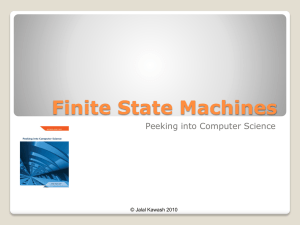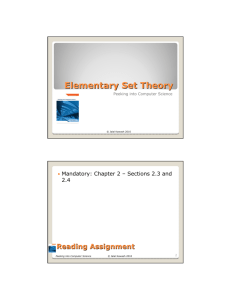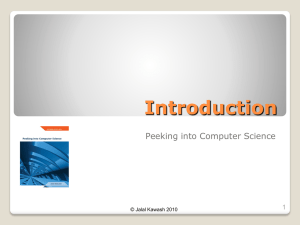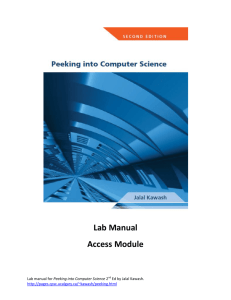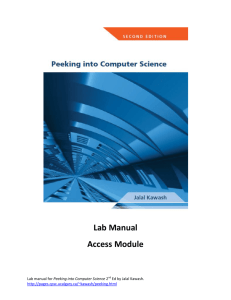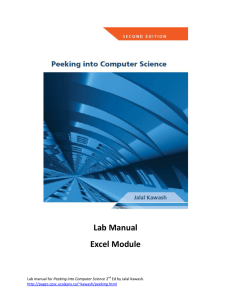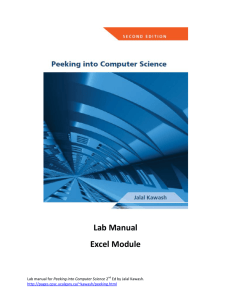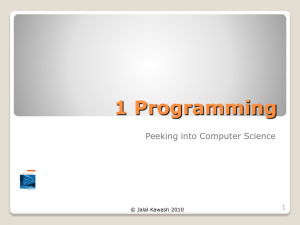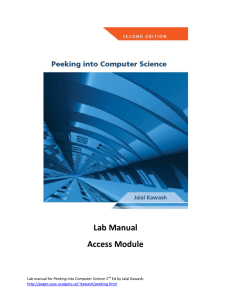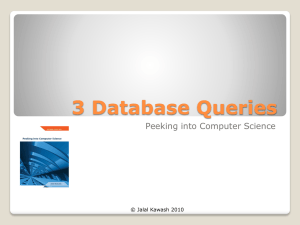Set relations and algorithms
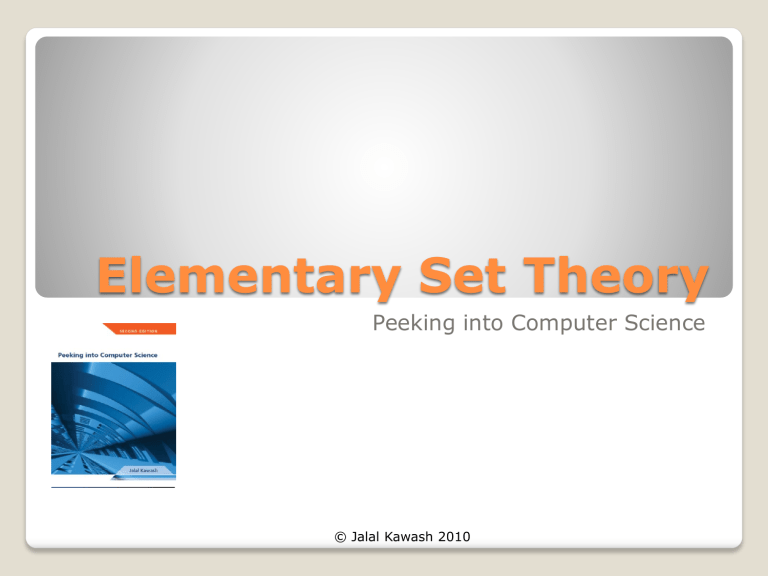
Elementary Set Theory
Peeking into Computer Science
© Jalal Kawash 2010
Mandatory: Chapter 2 – Sections 2.3 and
2.4
Reading Assignment
Peeking into Computer Science © Jalal Kawash 2010
2
Relations
Relating sets
3
At the end of this section, you will be able to:
1.
Define relations and represent them in two ways (sets and graphical)
2.
3.
Understand the property of symmetric relations
Identify which relation is a function
Objectives
Peeking into Computer Science © Jalal Kawash 2010
4
A relation from A to B is a subset of A x B
Example
◦ Let A = {book, lion, plate}
◦ Let B = {colored, made-from-paper, has-bones, contains-glass}
◦ The association of objects A with properties B is a relation from A to B
◦ R = {(book, colored), (book, made-from-paper),
(lion, has-bones), (plate, colored), (plate, madefrom-paper), (plate, contains-glass)}
In general, A relation on A subset of A
1 x A
2 x … x A n
1
, A
2
, … , A n is a
Relations
Peeking into Computer Science © Jalal Kawash 2010
5
Recall from the InfoViz slides (JT’s extra info on when to use images, what type etc.)
Graphical representations work well for showing how things are inter-related.
Consequently it may be easier to show relations between sets in the form of graph (image).
JT’s Extra: Relations And Pictures
Peeking into Computer Science © Jalal Kawash 2010
plate colored lion book made-from-paper has-bones
JT’s Extra: Relation Graph
(Previous Example)
Peeking into Computer Science © Jalal Kawash 2010 paper contains-glass
Relations can be directed (one way) as the previous example and the example below.
◦ Love graph: Problem! :’(
You Her Him Somebody else
Relations can also be symmetric (two way the same e.g., example below).
◦ Love graph: Life is good! :D
Her Him OR Her Him
Set Relations: Types
Peeking into Computer Science © Jalal Kawash 2010
Debra John Mike
Ali Sarah
“Likes” Relation Graph
Peeking into Computer Science © Jalal Kawash 2010
Alicia
9
Whenever (a,b)
∈
R, implies that (b,a) A
∈
R, the relation is called symmetric
Debra John Mike
Ali Sarah
Symmetric Relations
Peeking into Computer Science © Jalal Kawash 2010
Alicia
10
Has-the-same age
Has-the-same name
Children of a common parent
Symmetric Relations
Peeking into Computer Science © Jalal Kawash 2010
11
A function f from A to B
Written f: A B
Is a relation from A to B, such that:
There is exactly one pair (a,b) f for each a A
We write f(a) = b
Functions
Peeking into Computer Science © Jalal Kawash 2010
12
A = {1,2,3}, B={yes,no}
{( 1 ,yes), ( 2 ,yes), ( 3 ,no)} is a function
{(1,yes) ( 2 ,no), ( 2 ,yes), (3,no)} is not a function
{(2,yes), (3,no)} is not a function
Functions
Peeking into Computer Science © Jalal Kawash 2010
13
Functions “return values”
f(x) = 2x
f(1) returns 2
f(20) returns 40
Functions
Peeking into Computer Science © Jalal Kawash 2010
14
Algorithms
Computer recipes
15
At the end of this section, you will be able to:
1.
Understand what algorithms are and how to specify them
2.
3.
4.
5.
6.
Understand the importance of algorithms to computers
Understand what pseudo-code is
Develop and specify an example algorithm using pseudo-code
Differentiate between the correctness and efficiency of algorithms
Work out an example to assess the efficiency of algorithms
Objectives
16
Peeking into Computer Science © Jalal Kawash 2010
A problem is a specification of the relationship between input and output
◦ WHAT needs to be done, not HOW
Cooking problem
◦ Input: ingredients
◦ Output: cooked food
Computational problems are the ones to be carried out by computers
Problems
Peeking into Computer Science © Jalal Kawash 2010
17
The algorithm specifies how to solve the problem
◦ How to convert the input to output
Cooking problem
Cooking recipe (“algorithm?”)
Algorithms are specific to Computational problems
Algorithms
Peeking into Computer Science © Jalal Kawash 2010
18
780-850
Left behind the most important Math book
◦ Kitab Al Jaber Wal Mokaballa
◦ The book of Restoration and
Comparison
◦ Al Jaber (restoration) became
Algebra
When his book was translated to Greek, it was called: Thus said Algorismi
With time, it became algorithmi
Mohamed Bin Musa Al Khawarizmi
19
Peeking into Computer Science © Jalal Kawash 2010
Was given to mathematical operations used by merchant’s to simplify their accounting
Today, it is used to mean: computational procedure that accepts input, processes it, and produces output
‘Algorithm’
Peeking into Computer Science © Jalal Kawash 2010
20
input
Modern ‘Algorithm’
Peeking into Computer Science © Jalal Kawash 2010 output
21
1.
‘algorithm’ for washing your hair
Wet your hair
2.
3.
4.
5.
Open the shampoo bottle
Pour 5ml of shampoo to your palm
Apply to hair and rub for 1 minute
Rinse hair with water
Not really an algorithm, unless performed by a computer
Computational?
Peeking into Computer Science © Jalal Kawash 2010
22
Code (Computer program)
◦ Python and Jython
◦ Java
◦ C++
Finite State Machine
Pseudo-code
◦ English like code
Flow charts
◦ Visual representation
Specifying Algorithms
Peeking into Computer Science © Jalal Kawash 2010
23
Given a set of objects (numbers)
How do we find the smallest member of the set?
Example input : {10, 46, 3, 100}
Output: 3
Min Algorithm
Peeking into Computer Science © Jalal Kawash 2010
24
Given input S, a set
1.
Let the first element in S be min-so-far
2.
Check if the next element is less than min-so-far
◦ If so, make it the min-so-far
◦ If not ignore it
3.
4.
Repeat step 2 until all elements in S have been examined
The minimum is min-so-far
Attempt
Peeking into Computer Science © Jalal Kawash 2010
25
What if the input set is empty?
What if the input set is a singleton
(contains one element only)?
Problems with the attempt
Peeking into Computer Science © Jalal Kawash 2010
26
Input: set S
Output: minimum element in S
1.
2.
If S is empty, stop, there is no min
Otherwise, let the first element be MSF
3.
Repeat the following until all elements in S have been examined: check if the next element is less than MSF
4.
◦ If so, make it the MSF
◦ If not ignore it
The minimum is MSF
The Min Algorithm
Peeking into Computer Science © Jalal Kawash 2010
27
Algorithms must be correct
◦ Solve a problem, taking care of all special cases
Algorithms should be efficient
◦ Take less time to compute solution (timeefficiency)
◦ Use less space (space-efficiency)
◦ Use less power (power-efficiency)
◦ Use fewer message (message-efficiency)
Here, we only focus on time-efficiency
Correctness vs. Efficiency
Peeking into Computer Science © Jalal Kawash 2010
28
A merchant learnt that one of his 4096 golden coins is fake
All coins look exactly the same (including the fake one)
The only difference between a fake and a real coin is in the weight
A fake coin is lighter
Find an efficient algorithm to locate the fake coin
Hint: Can be done in 12 comparisons
Example
Peeking into Computer Science © Jalal Kawash 2010
29
8
4 4
2 2 2 2
1 1 1 1 1 1
A partial tree
Peeking into Computer Science © Jalal Kawash 2010
1 1
30
If you compare each pair of coins, you may need
4096/2 = 2048 “operations”
8.
9.
10.
11.
12.
4.
5.
6.
7.
1.
2.
3.
Weigh 2048 against 2048, pick the lighter pile
Weigh 1024 against 1024, pick the lighter pile
Weigh 512 against 512, pick the lighter pile
Weigh 256 against 256, pick the lighter pile
Weigh 128 against 128, pick the lighter pile
Weigh 64 against 64, pick the lighter pile
Weigh 32 against 32, pick the lighter pile
Weigh 16 against 16, pick the lighter pile
Weigh 8 against 8, pick the lighter pile
Weigh 4 against 4, pick the lighter pile
Weigh 2 against 2, pick the lighter pile
Weigh 1 against 1, pick the lighter coin
Efficient Algorithms
Peeking into Computer Science © Jalal Kawash 2010
31
It can be shown that the height of this binary tree is log number of coins
2
n, where n is the
log
2
4096 = 12
@#$$&^&)(&*^$##$%^$#
Logarithmic Time
Peeking into Computer Science © Jalal Kawash 2010
32
